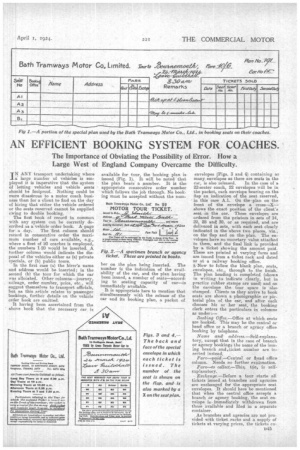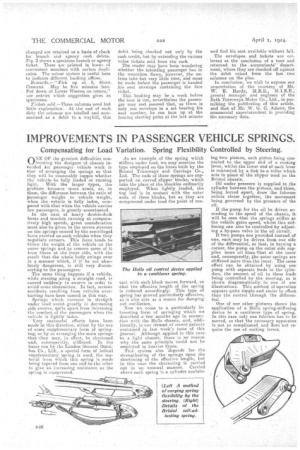AN EFFICIENT BOOKING SYSTEM FOR COACHES,
Page 39

Page 40

If you've noticed an error in this article please click here to report it so we can fix it.
The Importance of Obviating the Possibility of Error. How a Large West of England Company Overcame the Difficulty.
JN ANY transport undertaking where a: large number of vehicles is employed it le imperative that the system of letting vehicles and vehicle seats should be foolproof. Nothing could be more disastrous to a motor coach business than for a client to find on the day of hiring that either the vehicle ordered or the seats reserved cannot be supplied awing to double booking.
The first book of record in common with any system can be correctly described as a vehicle order book. A page for a day. The first column should record in consecutive order the maximum number of cars available, e.g., where a fleet of 20 coaches is employed, the numbers 1-20 would be inserted. A further column would indicate the disposal of the vehicles either as (a) private specials, or (b) public tours. In the first case (a) the hirer's name and address would be inserted; in the second (b) the tour for which the car a-as allocated. Other columns—journey, mileage, order number, price, etc., will suggest themselves to transport officials, but as this article relates to passenger bookings, further details on the vehicle order book are omitted.
It having been ascertained from the above book that the necessary car is
available for tour, the booking plan is issued (Fig. 1). It will be noted that the plan bears a mumber. It is the appropriate consecutive order number which follows the job through. No booking must be accepted without the Ram
her on the plan being inserted. The number is the indication of the availability of the car, and the plan having been issued, a number of seats—according to seating capacity of car—is immediately available. It is appropriate here to mention that. simultaneously with the release of the car and its booking plan, a packet of envelopes (Figs. 3 -and 4) containing as many, envelopes as there are seats in the
car, is also released. In the case of a 22-seater coach, 22 envelopes will be in the packet, each envelope bearing on the flap an indication of the Beat reserved, in this case Al. On the-plan on the front of the envelope a cross—X---shows the exact position of the client's seat in the car. These envelopes are ordered from the printers in sets of 14, 22, 28 and 30, or as required, and are delivered in sets, with each seat clearly indicated in the above two places, viz., on the flap and on the plan. The envelopes have no monetary value attached to them, and the final link is provided by a ticket showing the amount paid. These are printed at varying fares and are issued from a ticket rack and dated as at a railway booking office.
Now to follow the blank plan, seats, envelopes, etc., through to the finish. The plan heading is completed (shown in writing to indicate clearly, but in practice rubber stamps are used) and on the envelope the tour space is also stamped. Clients as they arrive to book seats are shown a photographic or pictorial plan of the car, and after each chooses his or her seat, the booking clerk enters the particulars in columns as under:— Booking Office—Office at which seats are booked. 'This may be the central or head office or a branch or agency office booking by telephone.
Name and address.—Sell-explanatory, except that in the case of branch or agency bookings the name of the issuing branch anditicket number are inserted instead.
Fare—paid.—CenEral or tread office column. Needs no further exiala.nation.
Fare—to collect.—This, tact, is selfexplanatory.
• Exchange.—Before a tour starts all tickets issued at branches and agencies are exchanged for the appropriate seat envelopes. It should here be mentioned that when the central office accepts a branch or agency booking,•the seat envelope is immediately withdrawn from those available and filed in a separate container.
As branches and agencies are not provided with ticket racks and a supply of tickets at varying prices, the tickets exD45 changed are retained as a basis of check for branch and agency cash debits. Fig. 2 shows a specimen branch or agency ticket. These are printed in books of convenient number& with carbon duplicates. The colour system is useful here to indicate different booking offices.
Ream ths.—" Pick up at .5, Sloan Crescent. May be five minutes late. Put down at Lower Weston on return," are entries which suggestion gives as speci mens.
T ickeis sold —These columns need but little explanation. At the end of each duty the columns are totalled and summarized as a debit to a waybill, this
debit being checked not only by the cash credit, but by extending the various value tickets sold from the rack.
The reader may have been 'wondering whether the intending passenger has in the meantime flown, however, the entries take but very little time, and must be made before the passenger is handed his seat envelope containing the fare ticket.
This booking may be a week before the tour is run, nevertheless the passenger may rest assured that, as there is only one envelope in a set bearing his seat number, he can turn -op at the touring starting point at the last minute
and find his seat available without fail.
The envelopes and tickets are collected at the conclusion of a tour and returned to the accountants'. department, where they are checked off against the debit raised from the last two
columns on the plan. .
In conclusion, we wish to express our appreciation of -the --courtesy of Mr. W. E. Hardy, M.B.E., M.I.E.E., general manager and engineer of the Bath Trarnwa.ys Motor Co., Ltd., in perinitting the publication of this article, and that of Mr. W. G. C. Adams, the commercial superintendent in providing the necessary data.






















































